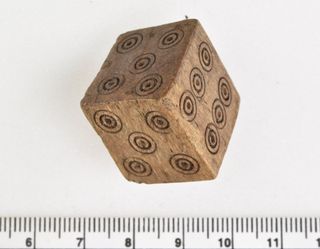 Although the discovery of one of over 30 dice in Bergen, Norway dating back to the medieval time period should not be any more interesting than the last, this one from a 15th century wooden street excavation is particularly puzzling. Most of the dice found in Bergen from this time period resemble that of the modern dice, this specific one, while shaped like the traditional six-sided cube, had two sides with four dots and two sides with five. Why was this one different from all of the rest? Two common theories arose from the discovery of this game piece found buried in a medieval street. One was that the die was meant for a particular game which required a piece with two sides of four and five dots, but because no other dice have been found that resemble it, the stronger theory is that it was used to cheat in gambling games.
Although the discovery of one of over 30 dice in Bergen, Norway dating back to the medieval time period should not be any more interesting than the last, this one from a 15th century wooden street excavation is particularly puzzling. Most of the dice found in Bergen from this time period resemble that of the modern dice, this specific one, while shaped like the traditional six-sided cube, had two sides with four dots and two sides with five. Why was this one different from all of the rest? Two common theories arose from the discovery of this game piece found buried in a medieval street. One was that the die was meant for a particular game which required a piece with two sides of four and five dots, but because no other dice have been found that resemble it, the stronger theory is that it was used to cheat in gambling games.Gambling and betting were banned in Bergen in 1276, however, archaeologists say that the ban didn't stop people from partaking in the activity considering this was discovered in the early 15th century. It can be inferred that the punishment was either not harsh enough on gambling to completely shut it down, or that there was enough money or reward involved that it was worth the risk. Not much is known about the purpose of this die, but it lets us look at the possible way people lived over 600 years ago.
Saraceni, Jessica E. “Unusual Die Unearthed in Norway.” Archaeology Magazine, 12 Apr. https://www.archaeology.org/news/6541-180412-norway-gambling-dice.
Jarus, Owen. “That's Cheating! Medieval Dice with No 1 or 2 Found on Street in Norway.” LiveScience, Purch, 11 Apr. 2018, https://www.livescience.com/62273-cheating-medieval-dice-norway.html.



Weird to think they gambled back then... I've been. SO not fun, unless you're actually winning.
ReplyDeleteIt's interesting to think about why they were willing to break the law to play a game. However, when comparing it to today, people break the law for many different reasons. If I had to guess, I would say that you were right in saying that "it was worth the risk". Maybe a bit of addiction played a part as well.
ReplyDeleteLike cdowden002 said, I find it very interesting that people in the middle ages were willing to break the law, but I can't say I'm particularly surprised, considering some people these days break the law to watch a TV show or play a video game for free. Although, I will also say, there's a distinct possibility the die pictured here could very well have been a mistake-- I know I would have made that mistake if I were in the middle ages!
ReplyDeleteI found it interesting how the Bergen dice in particular is unique in that it has two sides with both four and five dots; I had no idea there was such a thing as those kind of dice that existed in history. Along with the previous comments, I also find it intriguing that although gambling was banned in Bergen during the late 1200s, people were still devoted to the game and were willing to break the law in order to participate in it. You have a very insightful and well-written post and I especially like its title. Good job.
ReplyDeleteYes, very lively blog. We tend to view the Middle Ages as very authoritarian, top-down, church-imbedded. I like that the posts are revealing a more human and complex way of looking at the experiences of real people.
ReplyDelete